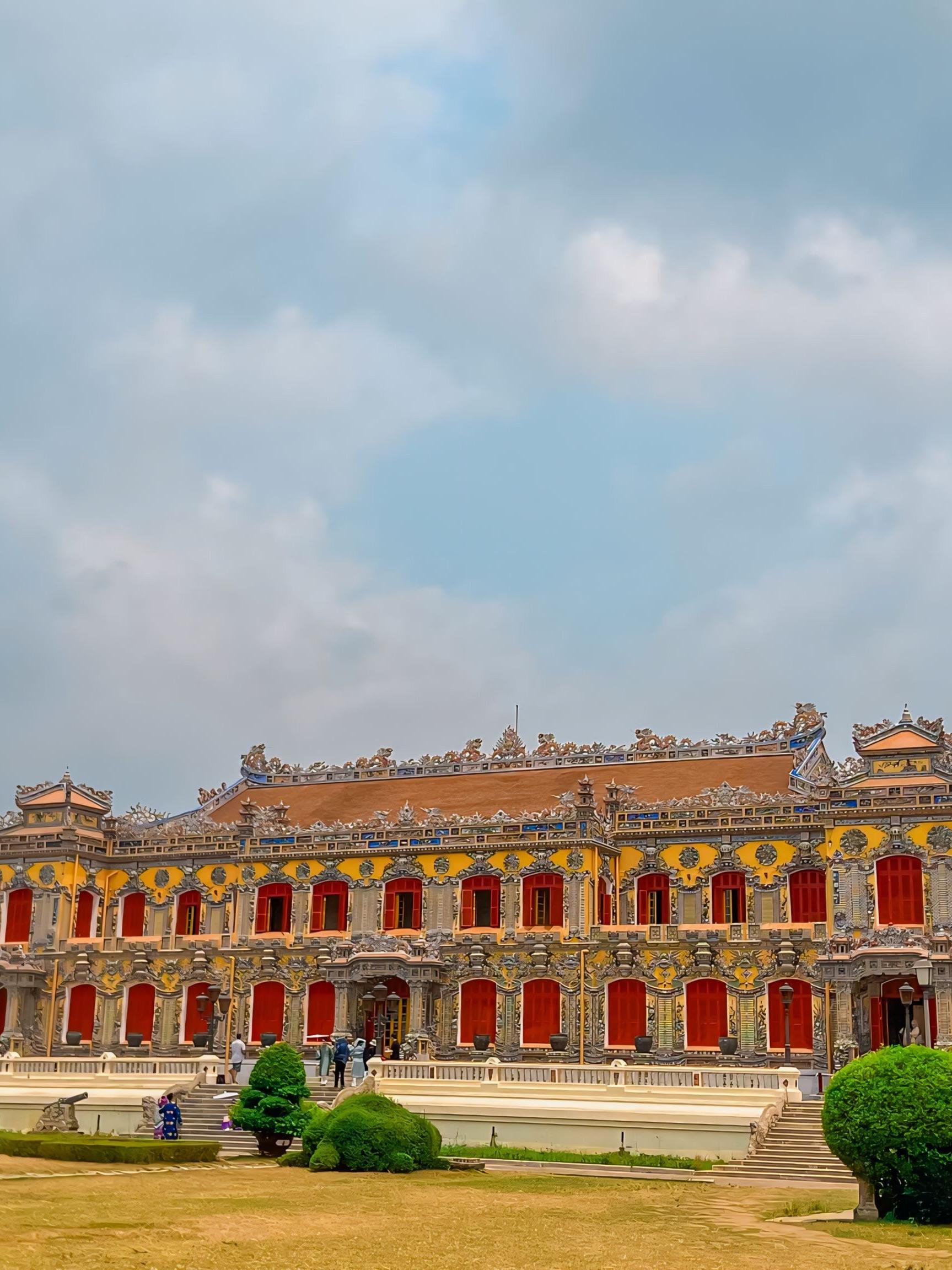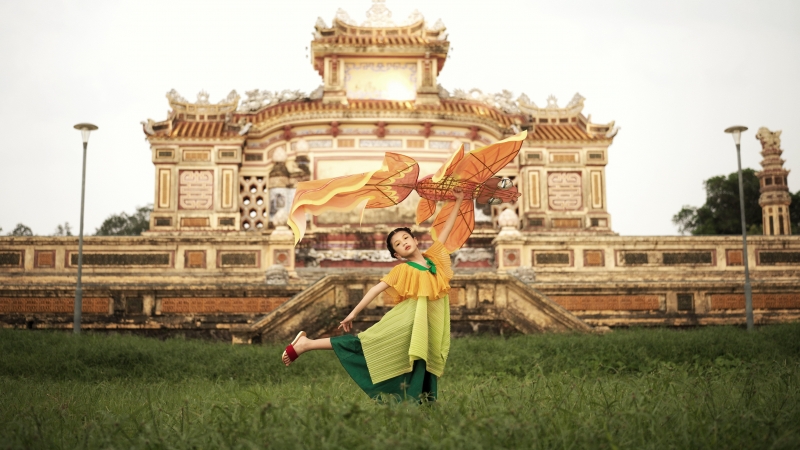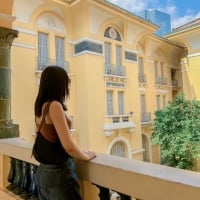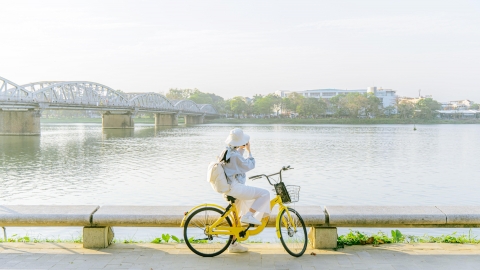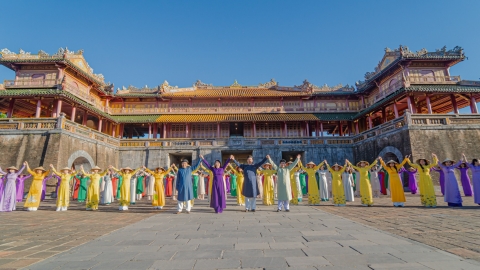As soon as it opened to visitors, Kien Trung Palace attracted a lot of visitors, especially during the recent April 30 - May 1 holiday. The attraction of Kien Trung Palace comes not only from its magnificent beauty but also from its great historical and cultural value.

Panoramic view of Kien Trung Palace from the main south direction of Hue Imperial Citadel.
A door leading to the past of the Nguyen Dynasty
Kien Trung Palace, once the residence of the last two kings of the Nguyen Dynasty, has now awakened after more than 70 years of silence. This place used to be the living and working place of King Khai Dinh and later became the private palace of King Bao Dai.
Kien Trung Palace is associated with many important historical events. On November 6, 1925, King Khai Dinh passed away in this main palace. This place also witnessed the important event when Queen Nam Phuong gave birth to Crown Prince Bao Long on January 4, 1936.
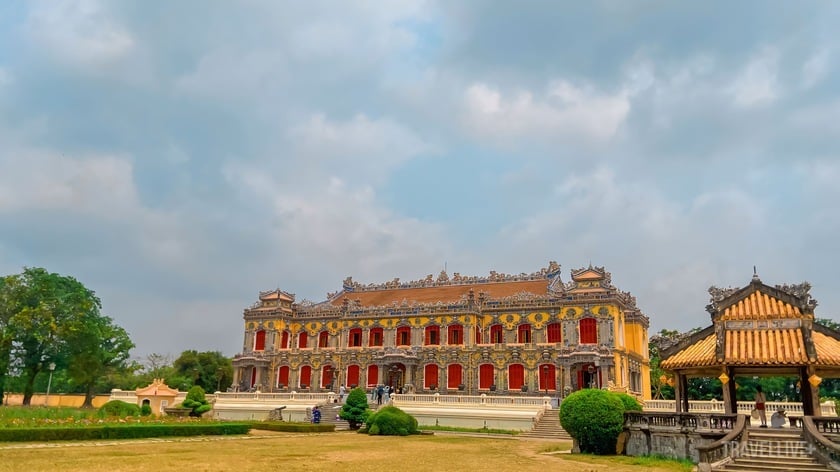
Garden space in front of Kien Trung Palace
In particular, Kien Trung Palace is also the place that marked an important historical milestone on August 29, 1945. Here, King Bao Dai had his first meeting with the delegation of the Provisional Government of the Democratic Republic of Vietnam to discuss his abdication. Then, on the afternoon of August 30, 1945, in front of tens of thousands of Hue people, King Bao Dai read the abdication proclamation, marking the end of the thousand-year feudal regime, opening a new era of independence and freedom for the nation.
However, due to the impact of war, Kien Trung Palace was completely destroyed in 1947, leaving only the foundation. This place has now become a historical relic, a reminder of a glorious period of history and the upheavals of the last feudal dynasty in Vietnam.

Kien Trung Palace, once the place of fame of the last two kings of the Nguyen Dynasty.
The majestic palace in the heart of Hue Ancient Capital
Kien Trung Palace has a unique beauty, a harmonious combination of French architecture, Italian Renaissance architecture and traditional Vietnamese architecture. The sophisticated patterns, vibrant colors and elaborate decorative details have created an extremely impressive architectural work.
Through the ups and downs of history, Kien Trung Palace has experienced periods of severe degradation and damage. However, thanks to the efforts of archaeologists and architects to restore and rebuild, Kien Trung Palace has gradually regained its original beauty.
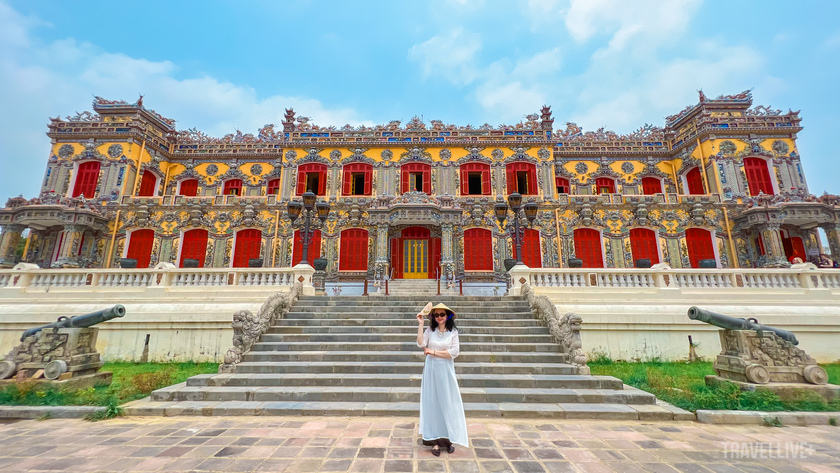
The unique beauty of Kien Trung Palace attracts special attention from domestic and foreign tourists.
The project to renovate, restore and embellish Kien Trung Palace relic was carried out on an area of over 3,800 m2, with the goal of preserving and promoting the historical and cultural values of this heritage. The construction units have adhered to the principle of keeping the existing foundation structure intact, minimizing intervention in the original elements of the relic.
The main Kien Trung palace building has two floors, is about 14 m high and has a construction area of about 975 m2.2The project focuses on renovating and restoring items such as tiled roofs, wooden frame systems, doors, walls, floors, decorative details... to ensure safety and preserve the unique architectural value of Kien Trung Palace.

The sophistication of ceramic mosaic art of Kien Trung palace.
The system of walls, railings, courtyards, and steps around the main building were also reinforced and restored to ensure the overall stability and aesthetics of the site. The project also renovated small structures around Kien Trung Palace such as brick pedestals, fountains, cannons, guardhouses, etc. to complete the overall architecture and landscape of the relic.
The project preserves the foundations of other structures in the Kien Trung Palace area such as the East Palace, the Royal Library, the Military Court Room and the Royal Court Room, contributing to the preservation of the historical and cultural values of the site. The green tree system in the site is added to create a beautiful landscape in harmony with the architecture of Kien Trung Palace.

The harmonious blend of two Asian and European architectural schools of Kien Trung Palace.
Facing the magnificence of Kien Trung Palace after being restored, many people were amazed by its beauty. That beauty made them even more surprised when they learned that, previously, Kien Trung Palace had been almost completely destroyed. The complete and magnificent restoration of such a massive architectural work is truly an extraordinary feat. The "rebirth" of Kien Trung Palace has aroused in the hearts of the Vietnamese people the hope of restoring other ancient architectural heritages across the country.
“Standing in front of the majestic Kien Trung Palace, I was filled with emotion mixed with amazement. The palace, which was almost completely destroyed, has now been fully and magnificently restored, making me admire the efforts and dedication of those who preserve the heritage. Every architectural detail and every decorative line has been meticulously recreated, bearing the mark of the Nguyen Dynasty. Looking at Kien Trung Palace, I feel like I have gone back in time, immersed in the historical space of the nation,” said Ms. Hoang Thi Bich Lien (a tourist from Hanoi).
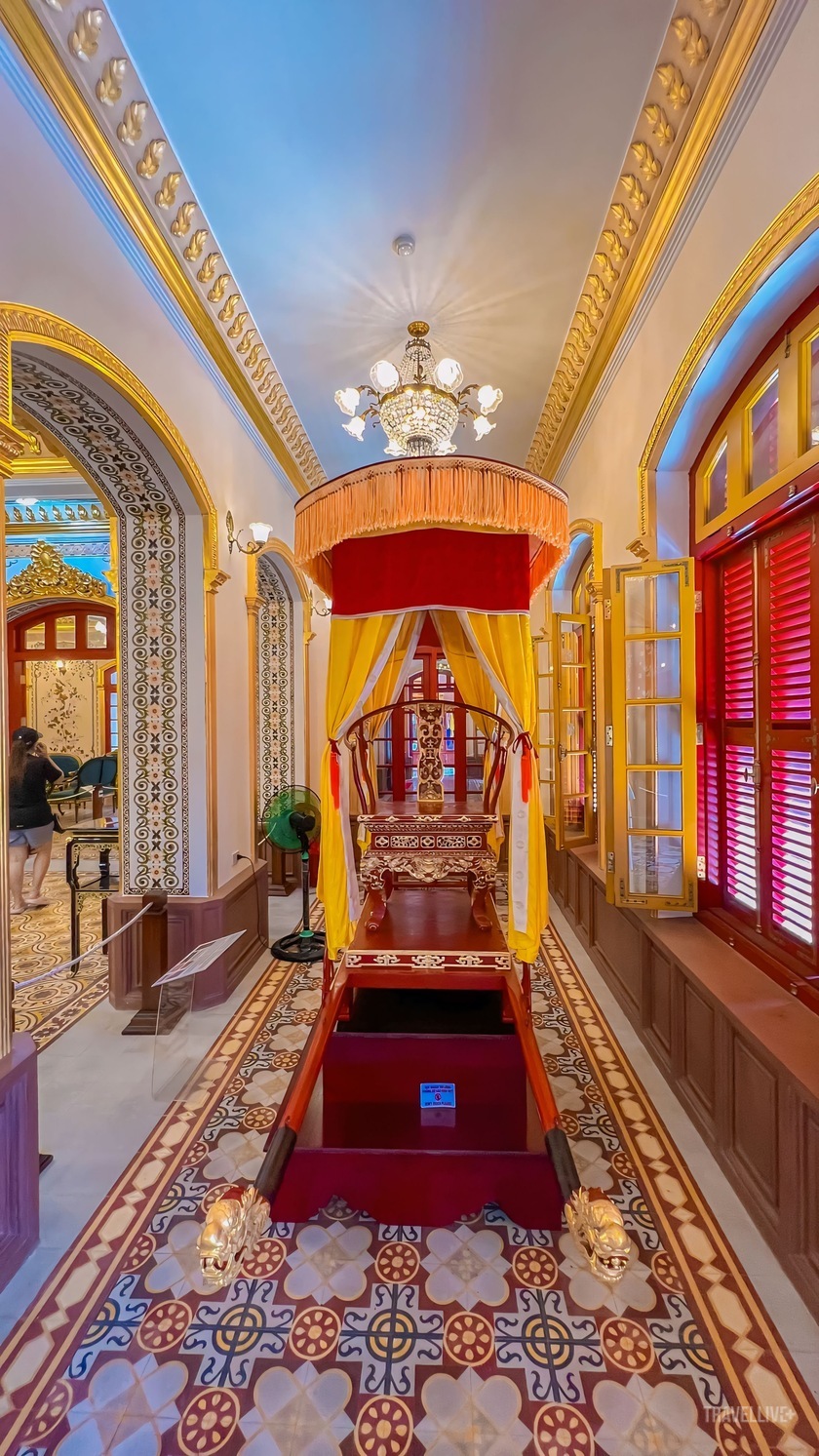
Interior of the palace
After completing the restoration project, the Hue Monuments Conservation Center has also worked hard to research and consult many historical sources to arrange and display valuable artifacts. Stepping into Kien Trung Palace, visitors cannot help but be amazed by the extremely rich and unique treasure trove of antiques. This place displays artifacts bearing the mark of the times, contributing to recreating the daily life of the Nguyen Dynasty kings, while revealing mysterious and fascinating historical stories.
The highlight that attracts tourists is the personal belongings of the two kings Khai Dinh and Bao Dai. Visitors can admire the shiny black leather shoes, the elaborately embroidered casual clothes of King Khai Dinh or the majestic golden dragon embroidered shoes of Crown Prince Vinh Thuy (later King Bao Dai). In addition, familiar objects in the life of kings such as wind chimes, tables and chairs, jars, cabinets inlaid with mother-of-pearl... are also solemnly displayed, contributing to recreating the luxurious and powerful living space of the Nguyen Dynasty kings.
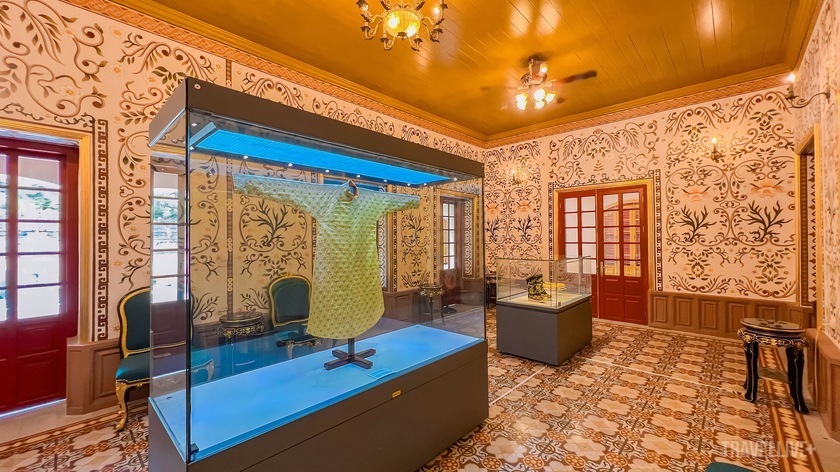
King Khai Dinh's plain clothes
In addition, visitors also have the opportunity to admire other valuable collections of antiques such as porcelain, bronze, paintings... Each artifact carries its own historical story, contributing to clarifying the cultural and social life of the Nguyen Dynasty in its final period.
With a scientific and methodical arrangement, along with a focus on preserving and maintaining artifacts, the Hue Monuments Conservation Center has turned Kien Trung Palace into a miniature museum, where visitors can experience and explore history in the most authentic and vivid way.
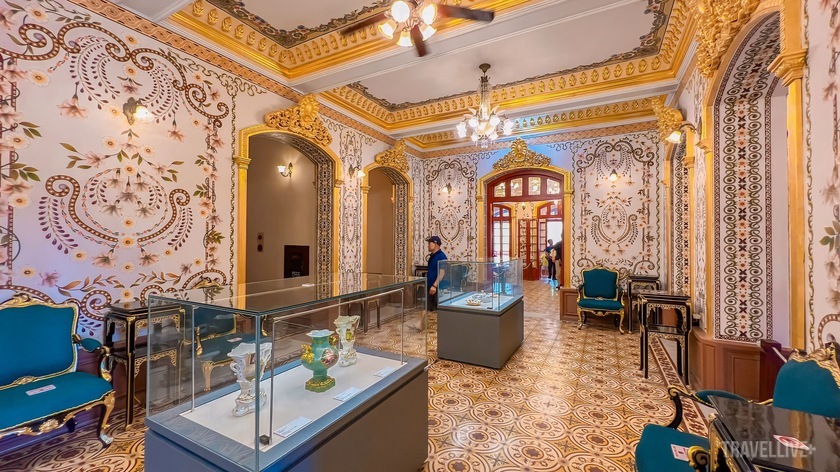
Impressive interior decoration of Kien Trung Palace.
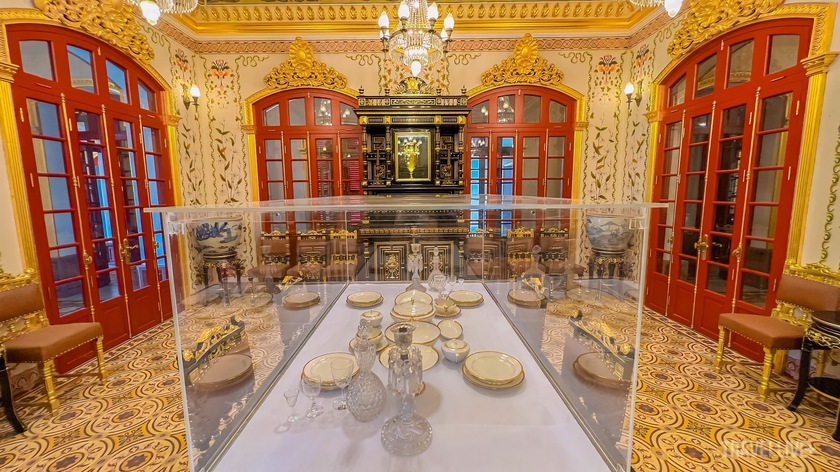
The porcelain plates were of the type used in the Imperial Palace.
More information:
According to information from the Department of Tourism of Thua Thien Hue province, during the long holiday from April 30 to May 1, the locality welcomed about 110,000 tourists to visit and relax. Of the number of tourists coming to Hue during the holiday, about 58,000 booked rooms, including 43,000 domestic tourists and 15,000 international tourists.
According to statistics from the Hue Monuments Management Board, during the 4-day holiday from April 27 to April 30, the Hue Monuments Complex welcomed 58,385 tourists. Of which, domestic visitors accounted for the majority with 43,510, international visitors had 14,875. Tourism revenue reached nearly 9 billion VND. Compared to the same period in 2023, the number of visitors to Hue during this year's holiday increased by 15.8%, tourism revenue increased by 9.7%. This is a positive signal for Hue's tourism industry after a long period of being affected by the Covid-19 epidemic.





